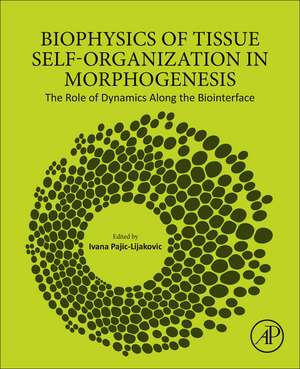Biophysics of Tissue Self-Organization in Morphogenesis: The Role of Dynamics Along the Biointerface
Editat de Ivana Pajic-Lijakovicen Limba Engleză Paperback – sep 2025
- Describes biological mechanisms of cell self-rearrangement from subcellular to supracellular levels
- Explores mathematical modelling approaches of tissue self-organization
- Considers engineering principles to solve biological and medical problems related to tissue self-organisation
- Discusses tissue self-organisation within various in vivo and in vitro organoid systems
Preț: 783.03 lei
Preț vechi: 860.46 lei
-9% Nou
Puncte Express: 1175
Preț estimativ în valută:
149.85€ • 154.81$ • 124.71£
149.85€ • 154.81$ • 124.71£
Carte nepublicată încă
Doresc să fiu notificat când acest titlu va fi disponibil:
Se trimite...
Preluare comenzi: 021 569.72.76
Specificații
ISBN-13: 9780443300486
ISBN-10: 0443300488
Pagini: 400
Dimensiuni: 191 x 235 mm
Editura: ELSEVIER SCIENCE
ISBN-10: 0443300488
Pagini: 400
Dimensiuni: 191 x 235 mm
Editura: ELSEVIER SCIENCE
Cuprins
Section 1: Tissues self-organisation in morphogenesis
1. Cell adhesion: Common mechanisms and physical principles
2. Analysis of the effect of cell movement on gene expression dynamics in development
3. Force transmission across scales: Examples and measuring methods
4. The impact of air pollution on the tissue self-organisation within co[1]cultured lung systems
Section 2: Physics of tissue self-organisation from subcellular to supracellular levels
5. How physical cues guide cell collectives, from local adhesion to global force transmission
6. Cellular death and division events at tissue interfaces: A chicken-or[1]the-egg situation
7. Active Nematics: Exploring the Interplay between structure and dynamics in cell cultures
8. The dynamics along the epithelial-cancer bio-interface within co[1]cultured cell spheroids: Physical aspects
9. Dynamical interplay at the interfaces of cancer cells, immune cells and stromal cells in the extracellular space of artificial model systems and tissues
10. Techniques development to quantify cell-scale dynamic mechanical interactions in extracellular matrices of tissues
Section 3: Modeling of the tissue self[1]organization
11. Mathematical modelling approaches to collective cell movement: Leader vs. follower cells
Section 4: Engineering of human tissues
12. Engineering of human tissues
13. Conclusion and outlook
1. Cell adhesion: Common mechanisms and physical principles
2. Analysis of the effect of cell movement on gene expression dynamics in development
3. Force transmission across scales: Examples and measuring methods
4. The impact of air pollution on the tissue self-organisation within co[1]cultured lung systems
Section 2: Physics of tissue self-organisation from subcellular to supracellular levels
5. How physical cues guide cell collectives, from local adhesion to global force transmission
6. Cellular death and division events at tissue interfaces: A chicken-or[1]the-egg situation
7. Active Nematics: Exploring the Interplay between structure and dynamics in cell cultures
8. The dynamics along the epithelial-cancer bio-interface within co[1]cultured cell spheroids: Physical aspects
9. Dynamical interplay at the interfaces of cancer cells, immune cells and stromal cells in the extracellular space of artificial model systems and tissues
10. Techniques development to quantify cell-scale dynamic mechanical interactions in extracellular matrices of tissues
Section 3: Modeling of the tissue self[1]organization
11. Mathematical modelling approaches to collective cell movement: Leader vs. follower cells
Section 4: Engineering of human tissues
12. Engineering of human tissues
13. Conclusion and outlook
